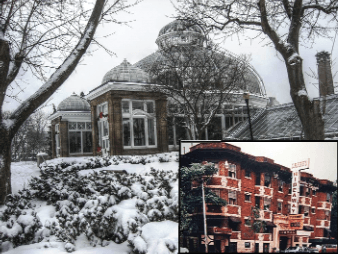Bruce bell –

In 1858 George William Allan a prominent Torontonian donated a 5-acre tract of land bounded by Carlton, Sherbourne and Jarvis Streets once part of his family’s enormous estate called Moss Park to the Toronto Horticultural Society.
Two years later on Sept. 11, 1860 HRH the Prince of Wales (later Edward VII) during his tour of North America opened the new Horticultural Gardens by planting a ceremonial maple tree much to the delight of the thousands who came out to witness this inaugural event despite a heavy rain.

Allan Gardens in its snowscape and (inset) when Larry’s Hideway occupied the site.
With its Walks and Gardens funds the City of Toronto in 1864 bought from George Allan the adjoining lands, which the City then handed over to the Toronto Horticultural Society on condition the entire grounds must be publicly accessible and free of admission charge.
The first public structure on the grounds, a rustic pavilion designed by Toronto architect William Hay in 1860, was demolished in 1878 and the following year a new and much larger Horticultural Pavilion made of wood, iron and glass opened to the public.
By the late 1880s the park, now home to the annual and extremely popular Chrysanthemum show, was becoming an cherished landmark to the citizens of Toronto.
It was also the setting to the Sunday temperance gatherings, concerts, operas and gala balls and was the place where nannies of affluent Jarvis families would take their charges for pram rides.
When illustrious guests came to Toronto, the Horticultural Gardens was the first place they were shown.
After his death in 1901 and as a tribute to the memory of George William Allan, the City of Toronto changed the name of the Horticultural Gardens to Allan Gardens and has remained to this day.
On June 16, 1902, a fire destroyed much of the Horticultural Pavilion and though part of the conservatory was kept open for several more years it would be in 1909 that architect Robert McCallum built the classically proportioned and domed Palm House that stands on the site today.
In July 1902, a life-sized statue of Scottish poet Robert Burns was unveiled by the Toronto Burns Monument Committee. This bronze statue cast by D. W. Stevenson of Edinburgh, Scotland, was presented to the city of Toronto and still stands today in the southeast end of the park. In 1913 two new greenhouses, also designed by McCallum, were added to the north and south ends of the Palm House which by then had outstanding collections of orchids, ferns and palms including the Queen Sago cycad plant which could be over 200 years old.
As Toronto grew and other parks were being planned Allan Gardens began its decline as the premier garden of our city.
After the WW2 the grounds became a much more informal gathering place and gone were the days of visiting royalty replaced with political and religious meetings. There were a few remembrances to its more genteel past however and in the summer months, the city parks department held weekly band concerts.
Between 1956 and 1963, during the time the parks department under the leadership of Tommy Thompson was bulldozing a swathe through Centre Island, they decided to revitalize Allan Gardens.
Thompson and his men expanded the park grounds, built a large gushing fountain, laid new pathways and added a new greenhouse wing to expand the conservatory.
In 1986 the Palm House was designated an architectural and historical landmark under the Ontario Heritage Act and with its new title the city began to preserve the greenhouse and its intricate gardens.
That same year Larry’s Hideaway a music venue tucked away in the basement of the former Prince Carlton Hotel (c1890) on the park‘s north end closed its doors.
While it was the antithesis of the rest of Allan Gardens, Larry’s was nonetheless a historic monument in its own right when it came to Toronto’s rock and roll history.
In LizWorth’s superb book Treat Me Like Dirt: An Oral History of Punk in Toronto and Beyond, 1977-1981,guitarist Chris Houston described Larry’s back room music venue, “You were lucky to get out of that room alive. Either the bouncers would kill you or there were strange people coming and going from the rooms.” Local music promoter Gary Topp says of Larry’s “Perhaps the most profound thing Larry’s gave the city was the environment for local punk, metal and other avant-garde acts at the time to cultivate and perform their original music, as well as providing people a place to discover this new music.”
Drugs, sex and rock ‘n roll. No other place in Toronto had the hard-core reputation that Larry’s had; a complete opposite from the days when nannies would take their charges for pram rides around the park.
In 1993 the city bought and demolished the 4- storey hotel and incorporated that once sketchy section of the park into green space.
Today Allan Gardens’ six greenhouses comprising over 16,000 square feet is open year round and is still free to the public.
For more than 150 years Allan Gardens has been a gathering place for rallies, demonstrations, music, poetry and enjoying Mother Nature‘s flowering treasures.
Join me in Chicago this September 1, 2, 3.
All-inclusive air, hotel, transfers, architectural tours. Information at www.brucebelltours.ca or call me 647-393-8687
 TheBulletin.ca Journal of Downtown Toronto
TheBulletin.ca Journal of Downtown Toronto

